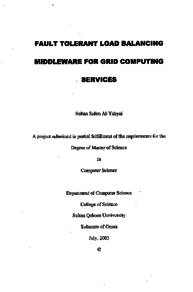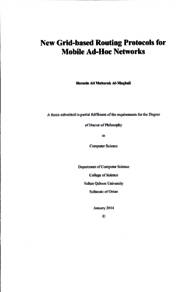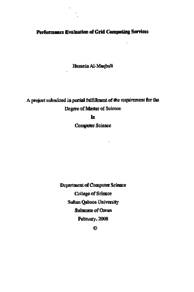وثيقة
Fault tolerant load balancing middleware for grid computing services.
الناشر
Sultan Qaboos University
ميلادي
2005
اللغة
الأنجليزية
الموضوع
الملخص الإنجليزي
Most of computer users spend their time reading some articles from the internet or doing their daily routine office work, so computers spend a lot of their time doing nothing. On the other hand many programs are on queue waiting for the availability of computational power. One can imagine how much power is available if we only consider the number of PC's connected to the internet. This encourages us to think about a way to utilize this power.
Grid computing has emerged as an important new field that focuses on large scale resource sharing. It has been an active area of research in the last few years and several experimental and commercial projects have been sponsored to implement Grid computing network middleware. The target of this project is to propose a network middle ware that supports task allocation and load balancing on a Grid computing environment. In this project, we first propose a new architecture for the Grid computing service and then design an adaptive load balancing algorithm. In the second part of this project, we survey the available technologies that support implementing the Grid computing service and then we implement a prototype for Grid computing service at Sultan Qaboos University (SQU).
Through this middleware, users can submit their computational tasks and the Grid system will do the computations on behalf of the user and then return the results back to the user. Thousands and thousands of tasks can be submitted by different users to the Grid at the same time, which raises the need of managing those tasks and the available resources.
The initial experimental results indicate the ability of our load balancing with different load traffics (balanced/unbalanced). It also compares the user response time and the system throughput of our proposed load balancing algorithm with a uniform distribution of the tasks without considering the processing capacity and the CPU utilization of the machines participating in the grid system.
المجموعة
URL المصدر
الملخص العربي
تمضي أجهزة الحواسيب الآلية معظم أوقاتها بدون عمل يمكنه استغلال قوتها الحاسوبية الكبيرة، حيث أن أكثر مستخدمي الحاسب الألي يمضون أوقاتهم في قراءة المقالات خلال شبكة المعلومات العالمية أو إنجاز أعمالهم المكتبية الروتينية. في الطرف الآخر نجد أن الكثير من البرامج في حالة انتظار بسبب عدم توفر القوه الحاسوبية اللازمة لتنفيذها. لهذا يمكن للملاحظ استنتاج مدى القوه الحاسوبية المهدوره باعتبار مجموع الحواسيب المكتبية الموصلة بشبكة الإنترنت. هذه الملاحظة تشجعنا على التفكير في طريقه للإستفادة من هذه الطاقة المهدوره تهدف الحاسبات الشبكية للإستفادة من هذه الطاقة المهدوره حيث أصبحت مجالا نشطا للبحوث في السنوات القليلة الماضية، حيث تم تمويل الكثير من المشاريع التجريبية والتجارية في هذا المجال. تمكن الحاسبات الشبكية المستخدمين من إرسال برامجهم ومن ثم تقوم الحاسبات الشبكية بتوفير القوه الحاسوبية اللازمة لتنفيذها. بعد الانتهاء من عملية التنفيذ، تقوم الحاسبات الشبكية بإعادة النتائج للمستخدم. آلاف المستخدمين يرسلون برامجهم للتنفيذ، مما يعني الحاجة إلى استراتيجية لإدارة هذه البرامج وإدارة الموارد الحاسوبية المتوفرة الهدف من هذا المشروع البحثي هو تطوير برامج وسيطة وخوارزميات تعمل على توزيع البرامج المستلمة على الموارد الحاسوبية بشكل يقلل وقت الإستجابة للمستخدم ويزيد من نسبة مخرجات للحاسبات الشيكية. كما يشمل هذا المشروع بناء نموذج أولي للحاسبات الشبكية في جامعة السلطان قابوس. في هذا الإطار قمنا بعمل دراسة مسحية التقنيات التي من خلالها نتمكن من بناء الحاسبات الشبكية تبين النتائج التجريبية المبدئية التي تم أجراؤها مقدرة الخوارزميات المقترحة على التعامل مع حالات مختلفه من الأعباء (متزنه وغير متزنه). كما تقارن هذه النتائج بين وقت الاستجابة للمستخدم و نسبة مخرجات الحاسبات الشبكية باستخدام الخوارزميات المقترحة وبين التوزيع المنتظم للعبء بدون اعتبار للقوه الحاسوبيه للأجهزه المشتركه في الحاسبات الشبكيه.
قالب العنصر
الرسائل والأطروحات الجامعية



